The 1997 BMW M3 stands as a testament to German engineering prowess, a car that redefined the performance landscape and captivated enthusiasts worldwide. This generation of the iconic M3 marked a significant evolution, introducing a potent 3.2-liter inline-six engine and a refined chassis that delivered both exhilarating speed and precise handling.
This car wasn’t just about raw power; it was about a holistic driving experience. From its sleek, aerodynamic design to its driver-focused cockpit, every element of the 1997 M3 was meticulously crafted to deliver an unforgettable journey. This was a car that could conquer winding roads with precision and grace, yet still offer a comfortable ride for daily commutes.
Its impact extended beyond the racetrack, influencing the design and performance of future generations of M3s and inspiring a generation of car enthusiasts.
The 1997 BMW M3: A Legacy Forged
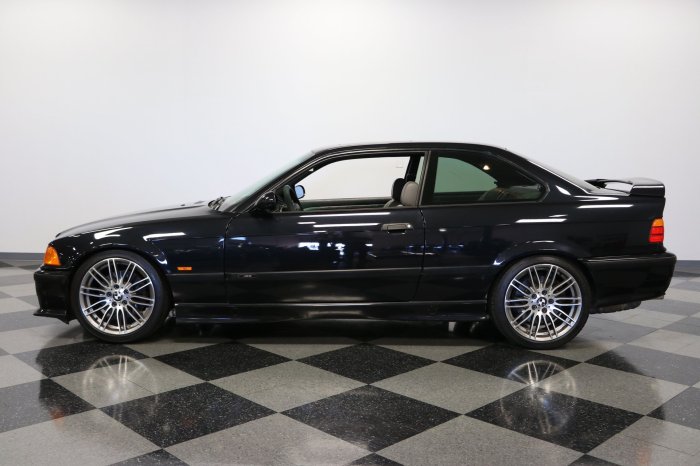
The 1997 BMW M3, the third generation of the iconic sports car, marked a significant evolution in the model’s history. Building upon the success of its predecessors, the E36 M3 introduced a host of innovations and refinements that solidified its reputation as a benchmark in the performance car segment.
It was not just an update, but a significant leap forward in both performance and refinement. The 1997 BMW M3’s significance lies in its ability to bridge the gap between a daily driver and a track-ready machine. This was achieved through a combination of cutting-edge engineering and a meticulous focus on driver engagement.
Key Features and Specifications
The 1997 BMW M3’s success was built on a foundation of exceptional engineering. Its key features and specifications made it a formidable contender on the track and a thrilling experience on the road:
- Powerful Engine:The heart of the E36 M3 was its 3.2-liter inline-six engine, a masterpiece of engineering that produced 240 horsepower and 236 lb-ft of torque. This engine was renowned for its smooth power delivery, high revving capability, and signature “M” engine note.
It was a testament to BMW’s commitment to naturally aspirated power and linear acceleration.
- Lightweight Construction:The E36 M3 prioritized performance by employing lightweight materials throughout its construction. Aluminum suspension components, a lightweight body, and a stripped-down interior contributed to a curb weight of around 3,100 pounds, allowing for a thrilling power-to-weight ratio.
- Exceptional Handling:The E36 M3’s handling was legendary. It featured a sophisticated double-wishbone front suspension and a multi-link rear suspension, which were meticulously tuned to provide precise steering, excellent grip, and balanced handling characteristics. The car’s low center of gravity and near-perfect weight distribution further enhanced its handling prowess.
- Six-Speed Manual Transmission:The E36 M3 was offered exclusively with a six-speed manual transmission, further emphasizing its focus on driver engagement. The gearbox was known for its precise shifts and short throws, allowing drivers to fully exploit the engine’s performance potential.
- Distinctive Styling:The E36 M3’s styling was both aggressive and elegant. It featured a wider track, flared wheel arches, a distinctive front bumper with a larger air intake, and a rear spoiler that provided additional downforce. The M3’s styling was a subtle yet effective way of communicating its performance intentions.
Development and Release
The development of the E36 M3 was a meticulous process. BMW’s engineers were determined to create a car that was not only fast but also refined and enjoyable to drive. They focused on enhancing the car’s handling, braking, and overall driving experience.
The E36 M3 was launched in 1995 and quickly gained a reputation for its exceptional performance and handling. It was a critical and commercial success, solidifying the M3’s position as one of the world’s most desirable sports cars.
Design and Styling
The 1997 BMW M3, a true icon of the automotive world, boasted a design that was both aggressive and elegant, embodying the spirit of performance and refinement. Its distinctive features and aerodynamically optimized bodywork set it apart from the crowd, making it a true head-turner.
Exterior Design
The 1997 BMW M3’s exterior design was characterized by its sleek, muscular lines and aggressive stance. The front fascia featured a large, prominent grille, flanked by twin round headlights and a prominent air dam. The side profile showcased the car’s low, wide stance, with sculpted side skirts and flared wheel arches that hinted at the power lurking beneath.
At the rear, the M3 sported a distinctive diffuser, quad exhaust tips, and a subtle rear spoiler.
Aerodynamics
Aerodynamics played a crucial role in the 1997 BMW M3’s performance. The car’s sculpted bodywork, including the front air dam, rear diffuser, and subtle spoiler, worked in unison to reduce drag and increase downforce. This resulted in improved stability at high speeds and enhanced handling characteristics.
The 1997 BMW M3’s aerodynamic design was a testament to BMW’s engineering prowess, contributing significantly to its performance and handling capabilities.
Interior Design
The interior of the 1997 BMW M3 was a driver-focused cockpit, designed to provide a rewarding and engaging driving experience. The driver’s seat was supportive and comfortable, with a commanding view of the road ahead. The dashboard was clean and functional, featuring high-quality materials and a logical layout.
The steering wheel was thick and grippy, providing excellent feedback to the driver.
The 1997 BMW M3, with its iconic flared wheel arches and powerful inline-six engine, was a defining sports car of the era. While the M3 offered a focused, track-oriented experience, BMW also introduced a more relaxed and stylish alternative: the 2003 BMW Z4.
This roadster, with its sleek lines and folding hardtop, provided a more comfortable and open-air driving experience, while still carrying the hallmark BMW performance and handling. The M3, however, remained the ultimate driver’s car, offering a raw and engaging experience that continues to be coveted by enthusiasts today.
- Materials:The interior of the 1997 BMW M3 featured a blend of high-quality materials, including leather, Alcantara, and brushed aluminum. These materials were chosen for their durability and luxurious feel.
- Driver Experience:The driver-centric design of the 1997 BMW M3 provided a truly engaging driving experience. The supportive seats, responsive steering, and well-placed controls allowed drivers to connect with the car and enjoy its performance potential.
Engine and Performance
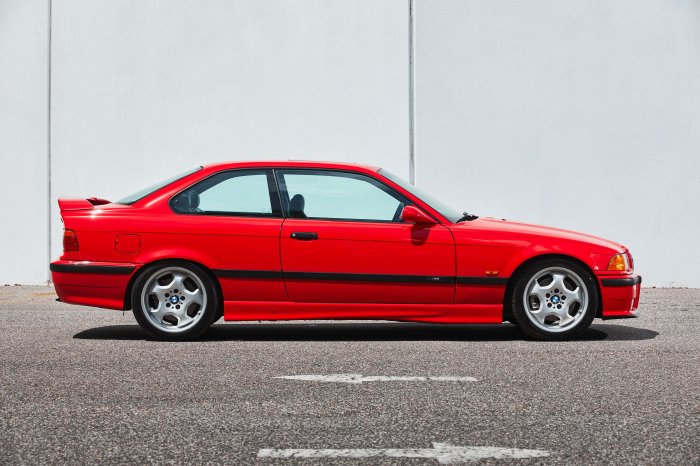
The 1997 BMW M3 was a powerhouse, equipped with a high-revving, naturally aspirated engine that delivered exhilarating performance. Its engine was a testament to BMW’s engineering prowess, combining power and efficiency.
Engine Specifications, 1997 BMW M3
The 1997 M3 was powered by a 3.2-liter, inline-six engine, codenamed S50B32. This engine produced an impressive 240 horsepower at 7,400 rpm and 236 lb-ft of torque at 3,250 rpm. This powerplant was known for its smooth and linear power delivery, allowing for effortless acceleration and a thrilling driving experience.
The 1997 BMW M3, with its iconic S50 engine, represented a significant leap forward in performance and handling. However, the car’s lineage can be traced back to the earlier BMW models, like the elegant 1971 BMW 2800CS , which emphasized a more refined driving experience.
While the 2800CS was known for its smooth power delivery and luxurious interior, the 1997 M3 took a different approach, prioritizing track-focused performance with its aggressive styling and powerful engine.
Performance Metrics
The 1997 M3 was a true performance machine, capable of reaching a top speed of 155 mph (electronically limited). Its acceleration was equally impressive, with a 0-60 mph time of 5.8 seconds. This performance was achieved through a combination of factors, including the lightweight construction, aerodynamic design, and powerful engine.
Handling and Dynamics
Beyond its raw power, the 1997 M3 was renowned for its exceptional handling and dynamics. Its precise steering, balanced suspension, and powerful brakes allowed drivers to navigate corners with confidence and precision. The car’s handling characteristics were praised by automotive journalists and enthusiasts alike, solidifying its reputation as a true driver’s car.
Performance Comparison with Competitors
The 1997 M3 faced stiff competition from other high-performance sports cars, such as the Porsche 911 and the Honda NSX. While the Porsche 911 offered superior power and handling, the M3 was considered a more affordable and practical option. The Honda NSX, with its mid-engine layout, provided a more exotic and exhilarating driving experience, but it was significantly more expensive.
The 1997 M3 found its niche by offering a balance of performance, affordability, and practicality, making it a popular choice for enthusiasts seeking a thrilling driving experience.
Technology and Features
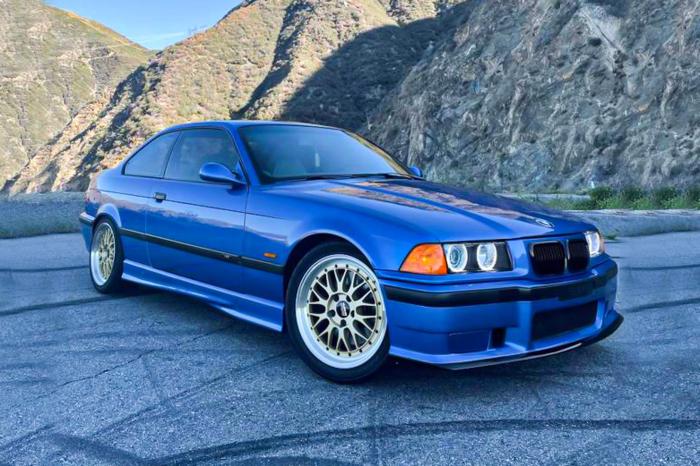
The 1997 BMW M3 was a technological marvel for its time, showcasing innovations that enhanced performance, handling, and driver experience. This section delves into the key technological advancements, safety features, and available options that made the 1997 M3 a standout in the automotive landscape.
Technological Advancements
The 1997 BMW M3 incorporated several groundbreaking technologies that significantly impacted its performance and handling. The most notable advancement was the introduction of the Variable Valve Control (VANOS)system. This system allowed for precise control of valve timing and lift, resulting in optimized power delivery across the entire rev range.
The M3 also featured an Electronic Stability Program (ESP), a pioneering safety feature that provided electronic assistance to maintain stability during cornering and braking.
Safety Features
Safety was paramount in the 1997 M3, and the car was equipped with an array of features designed to protect the driver and passengers. These included:
- Dual front airbags: The M3 was one of the first cars in its segment to offer dual front airbags as standard equipment, providing crucial protection in frontal collisions.
- Anti-lock Braking System (ABS): ABS prevented wheel lockup during hard braking, ensuring maximum control and stopping power.
- Electronic Stability Program (ESP): ESP, as mentioned earlier, played a crucial role in maintaining vehicle stability, particularly during challenging driving conditions.
Available Options and Packages
BMW offered a range of options and packages for the 1997 M3, allowing buyers to personalize their cars according to their preferences. Some of the notable options included:
- Sunroof: A power sunroof provided a panoramic view and improved ventilation.
- Leather upholstery: High-quality leather seats enhanced the interior’s luxury and comfort.
- Navigation system: A factory-installed navigation system provided turn-by-turn directions, enhancing convenience and reducing driver distraction.
- Sport Package: This package included a sport suspension, larger wheels, and a limited-slip differential, further enhancing the car’s performance and handling.
Legacy and Impact
The 1997 BMW M3 left an indelible mark on the automotive landscape, establishing a benchmark for performance and handling that resonated through subsequent generations of the iconic model. Its legacy is a testament to its engineering prowess, captivating design, and enduring popularity among enthusiasts and collectors.
The 1997 BMW M3’s Influence on Subsequent Generations
The 1997 M3 served as a blueprint for future generations, shaping the core principles of the M3 lineage. Its emphasis on driver engagement, precise handling, and a potent yet refined powertrain became defining characteristics of subsequent models. The car’s lightweight construction, honed suspension, and powerful yet tractable engine laid the foundation for the M3’s enduring success.
- The 1997 M3’s lightweight construction, achieved through extensive use of aluminum, set a precedent for future M3 models, emphasizing the importance of weight reduction for enhanced performance.
- Its double-wishbone front suspension and multi-link rear suspension provided exceptional handling and road-holding, inspiring subsequent M3 generations to refine and improve upon these systems.
- The 3.2-liter inline-six engine, producing 240 horsepower, offered a balance of power and efficiency, setting the stage for the M3’s reputation for potent yet refined powertrains.
The 1997 BMW M3’s Popularity Among Car Enthusiasts and Collectors
The 1997 M3 has garnered a loyal following among car enthusiasts and collectors, becoming a highly sought-after classic. Its timeless design, exceptional performance, and historical significance have cemented its status as a collector’s car.
- The car’s iconic design, featuring flared wheel arches, a distinctive front bumper, and a rear spoiler, has aged gracefully, remaining visually appealing to this day.
- Its performance capabilities, highlighted by its responsive engine, precise handling, and excellent braking, continue to impress enthusiasts and collectors.
- The 1997 M3’s status as a rare and desirable model, with a limited production run, has contributed to its increasing value among collectors.
Cultural Significance
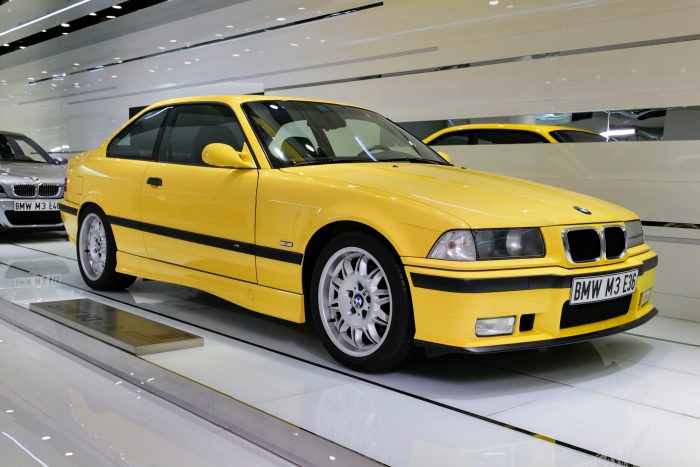
The 1997 BMW M3 transcended its status as a high-performance sports car, becoming a cultural icon that resonated with enthusiasts and the general public alike. Its presence in media, motorsport achievements, and design elements contributed to its enduring legacy.
Presence in Media and Popular Culture
The 1997 M3 made frequent appearances in popular culture, solidifying its image as a symbol of speed, luxury, and exclusivity. Its sleek design and powerful performance caught the attention of filmmakers, television producers, and video game developers. Notably, the car featured prominently in the 2001 film “The Fast and the Furious,” further boosting its recognition among a younger generation.
The 1997 BMW M3, with its iconic flared wheel arches and high-revving inline-six engine, cemented the M division’s reputation for performance. While BMW’s focus shifted towards more practical models in the following years, the spirit of the M3 lived on in the 2008 BMW 1 Series.
This compact hatchback, while not as overtly aggressive as the M3, offered a similar blend of sharp handling and engaging driving dynamics, proving that BMW’s commitment to driving pleasure remained a core principle.
Role in Motorsport
The 1997 M3’s racing heritage is deeply intertwined with its cultural significance. BMW’s commitment to motorsport led to the development of the M3 for the German Touring Car Championship (DTM). The car’s dominance in the DTM, particularly during the 1990s, solidified its reputation as a formidable competitor.
Its success on the track contributed to its popularity among racing enthusiasts and showcased its engineering prowess.
Symbol of Performance and Luxury
The 1997 M3’s combination of performance and luxury became a defining characteristic of the BMW brand. Its powerful engine, precise handling, and luxurious interior appealed to drivers seeking both excitement and comfort. The car’s distinctive design, featuring flared wheel arches, a sporty front bumper, and a rear spoiler, further enhanced its appeal.
This blend of performance and luxury cemented its status as a desirable and aspirational vehicle.
Collecting and Restoration
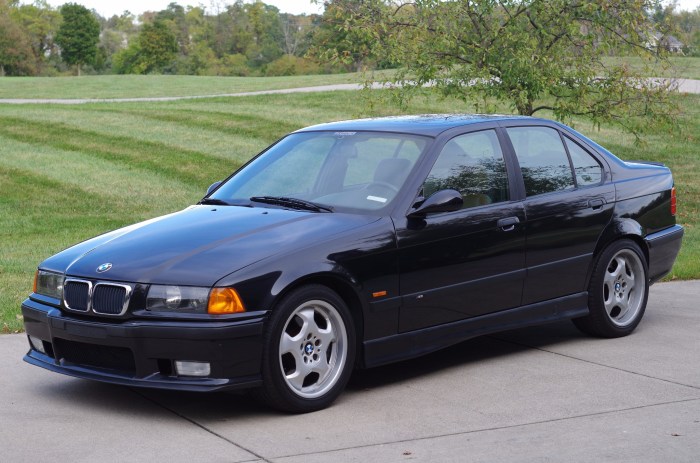
The 1997 BMW M3, a car that embodies the spirit of performance and elegance, has become a coveted collectible for enthusiasts worldwide. Its timeless design, potent engine, and legendary handling have cemented its place in automotive history. As the years pass, the 1997 M3’s value continues to climb, making it a desirable investment for collectors and enthusiasts alike.
Market Value and Collector Appeal
The 1997 BMW M3’s value has steadily appreciated over the years, reflecting its enduring appeal and limited production. The average price for a well-maintained 1997 M3 in good condition can range from $20,000 to $40,000, depending on factors such as mileage, condition, and modifications.
However, pristine examples with low mileage and a documented history can fetch significantly higher prices, exceeding $50,000 or even $60,000. The car’s rarity, its iconic status, and its strong performance make it a desirable investment for collectors and enthusiasts seeking a piece of automotive history.
Factors Influencing Value and Desirability
Several factors contribute to the value and desirability of a 1997 BMW M
3. These factors can be categorized as follows
- Condition: A well-maintained 1997 M3 with original paint, interior, and mechanical components is highly sought after by collectors. A comprehensive service history and documentation of any repairs or modifications further enhance its value. Conversely, cars with significant damage or modifications may command lower prices.
- Mileage: Lower mileage is generally associated with higher value. Cars with under 100,000 miles are considered desirable, while those with over 150,000 miles may command lower prices. However, a well-maintained high-mileage car with a documented service history can still be a valuable collectible.
- Options: Certain options, such as the M-Sport package, sunroof, and leather interior, are highly sought after by collectors. These options add to the car’s desirability and can increase its value.
- Rarity: Certain variants of the 1997 M3, such as the limited-edition “Lightweight” model, are highly sought after by collectors due to their rarity. These cars can command significantly higher prices than standard models.
- History: A documented history, including service records, ownership records, and any awards or accolades, can significantly increase a 1997 M3’s value. Collectors often prefer cars with a known history, as it provides a sense of authenticity and provenance.
Restoration Process
Restoring a 1997 BMW M3 to its original condition can be a rewarding but challenging endeavor. The process typically involves the following steps:
- Assessment: The first step is to assess the car’s condition and identify any areas that need restoration. This includes evaluating the bodywork, paint, interior, and mechanical components.
- Disassembly: Once the assessment is complete, the car is disassembled to allow for individual components to be restored. This involves removing the engine, transmission, suspension, interior, and exterior panels.
- Bodywork and Paint: Any rust or damage to the bodywork is repaired, and the car is repainted in its original color. This process requires specialized skills and equipment to ensure a high-quality finish.
- Interior Restoration: The interior is restored to its original condition, including replacing worn or damaged seats, carpets, and trim. This may involve sourcing original parts or using high-quality reproductions.
- Mechanical Restoration: The engine, transmission, suspension, and brakes are thoroughly inspected and restored to their original specifications. This may involve rebuilding or replacing components to ensure proper function.
- Reassembly: Once all components have been restored, the car is reassembled. This process requires meticulous attention to detail to ensure that everything is properly fitted and aligned.
- Testing and Refinement: After reassembly, the car is thoroughly tested to ensure that everything is functioning correctly. Any minor adjustments or refinements are made to achieve optimal performance.
Final Conclusion
The 1997 BMW M3 remains a highly sought-after classic, its timeless design and exceptional performance cementing its status as a legend. Whether cruising down a highway or tackling a challenging track, this car continues to captivate with its blend of power, agility, and refined driving experience.
For car enthusiasts and collectors alike, the 1997 M3 represents a pinnacle of automotive excellence, a legacy that continues to inspire and impress.